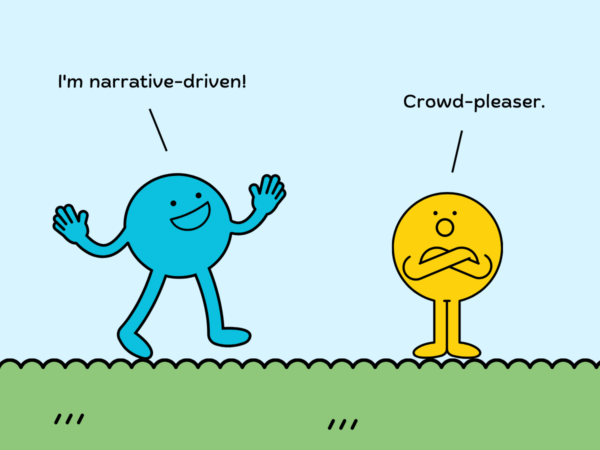When it comes to storytelling, two prominent approaches often emerge: character-driven and narrative-driven stories. As a filmmaker, understanding the nuances and strengths of each can greatly enhance your ability to create compelling narratives. In this article, we will explore their definitions and examine their effective use in the realm of short films. Get ready to unlock the secrets of crafting engaging and unforgettable stories that will leave a lasting impact on your viewers.
1. Definition of character-driven and narrative-driven stories
Character-driven stories focus on the development, growth, and internal journey of the characters. These narratives prioritize the emotional depth, motivations, and conflicts of the characters, aiming to create relatable and well-rounded individuals that resonate with the audience. For clarity, let’s give some examples from classic feature films anyone should have seen.
Character-driven (feature) film examples:
- Moonlight (2016): Directed by Barry Jenkins, this coming-of-age drama tells the story of a young African-American man, played by three different actors at different stages of his life. The film explores themes of identity, sexuality, and personal transformation.
- Boyhood (2014): Directed by Richard Linklater, this film follows the life of a young boy, played by Ellar Coltrane, as he grows up over the course of 12 years. The focus is on the character’s coming-of-age journey and the relationships and experiences that shape him.
In contrast, narrative-driven stories emphasize the overall plot, events, and story arc. These narratives often rely on suspense, high stakes, or intricate plots to keep audiences engaged. The focus lies in crafting a compelling sequence of events that propel the story forward, captivating viewers with its twists and turns.
Narrative-driven (feature) film examples:
- Memento (2000): The story unfolds in a non-linear structure, compelling viewers to piece together fragments of information to understand the protagonist’s motivations and the overall narrative.
- Gone Girl (2014): Directed by David Fincher, this thriller explores the disappearance of a woman and the subsequent investigation into her husband’s potential involvement. The narrative is driven by the twists and turns, the unreliable narrators, and the exploration of deception and manipulation.
2. Common weaknesses in character-driven and narrative-driven short films
Knowing which narrative model applies to your story is good, but making sure you don’t fall into common pitfalls is even more important. We have summed up for you some of the most common problems we identify in character-driven and narrative-driven short films.
Common weaknesses in character-driven short films
- Lack of plot progression: In character-driven stories, the focus on character development can sometimes overshadow the need for a strong and engaging plot. If the plot fails to progress, the story may become stagnant or meandering, potentially losing the audience’s interest. A compelling external conflict should be present to avoid this.
- Slow pacing: Character-driven stories often require time to delve deep into the characters’ emotions, conflicts, and growth. However, if not managed carefully, this emphasis on introspection and character exploration can lead to a slow pace that might bore some viewers. Balancing introspection with moments of action or tension can help maintain the story’s momentum.
- Inconsistency in character arcs: Character-driven stories often rely on the growth and transformation of the characters. In many short films, we notice the difficulty of choosing a story suitable for the short format, in which forcings in character arcs dictated by the limited time available do not compromise the credibility of the characters.
- Difficulty in maintaining audience engagement: Without a well-crafted balance between character development and engaging plot elements, character-driven stories may struggle to sustain audience engagement, especially if the audience does not connect strongly with the characters. It’s important to continually provide compelling narrative hooks, conflicts, or surprises that keep the audience invested throughout the story.
Common weaknesses of narrative-driven short films
- Insufficient emotional connection: With the emphasis on plot and events, narrative-driven stories may struggle to establish a strong emotional connection between the audience and the characters. The focus on external conflicts and high-stakes situations may overshadow the exploration of the characters’ inner lives and emotions. Finding opportunities to delve into the character’s emotional journeys can enhance the audience’s investment in the story.
- Overreliance on plot twists that can result as forced: Narrative-driven stories often incorporate plot twists and unexpected turns to maintain audience interest and create suspense. However, relying too heavily on these twists without proper setup or justification can lead to a sense of contrivance or gimmickry. Plot twists should be organic, well-integrated into the narrative, and serve a purpose beyond mere surprise.
- Sacrificing character development for plot progression: In the pursuit of a fast-paced and event-driven narrative, character development may take a backseat. Characters may lack growth or change, and their arcs may feel overshadowed by the demands of the plot. Balancing the need for plot progression with meaningful character development is crucial to avoid this weakness.
- Lack of thematic depth: Narrative-driven stories that prioritize plot and action may sometimes overlook the exploration of deeper themes and ideas. While entertaining, these stories may not leave a lasting impact or provoke thought and reflection. Incorporating thematic elements and exploring thought-provoking ideas can enrich the narrative and provide a more meaningful experience for the audience.
3. Which of the two storytelling types is better suited for short films?
Short films are a flexible medium, and filmmakers have the freedom to experiment with various approaches. Some short films successfully combine elements of character-driven narratives with concept-driven or event-driven elements, allowing for nuanced storytelling within the limited runtime.
In the short film form, the best-suited approach depends on the specific goals and intentions of the filmmaker. However, due to the limited duration of short films, it can be challenging to fully explore complex character-driven narratives or delve into intricate plot developments.
Two subsets of narrative-driven storytelling work particularly well in the short form, because they can provide an effective narrative in little time.
Event-driven stories
In event-driven stories, the primary driving force behind the narrative is significant events or incidents that occur within the story. These events propel the plot forward, create conflicts, and shape the characters’ experiences and development.
By highlighting the importance of significant events, event-driven stories may prioritize the external conflicts and external forces that shape the story. Character development can still be present in event-driven stories, though it may be more directly influenced by the events unfolding in the narrative.
Event-driven (feature) film examples:
Jurassic Park (1993): Directed by Steven Spielberg, this film centers around a theme park filled with genetically resurrected dinosaurs. The key events driving the story are the escape and subsequent chaos caused by the dinosaurs, with the characters trying to survive and prevent further destruction.
Gravity (2013): Directed by Alfonso Cuarón, this film focuses on the harrowing events faced by two astronauts stranded in space after their shuttle is destroyed. The narrative revolves around the intense events and challenges the characters encounter as they fight for survival in a hostile environment.
Concept-driven stories
In concept-driven stories, the central focus is on a unique or thought-provoking concept or premise. The concept itself becomes a driving force in the narrative, shaping the plot and character dynamics.
Concept-driven stories often aim to challenge conventional thinking, present alternative perspectives, or explore hypothetical scenarios. The concept becomes a driving force behind the narrative, shaping the events, conflicts, and themes of the story.
As a subset of narrative-driven stories, concept-driven narratives can incorporate elements of both character development and plot progression.
Concept-driven (feature) film examples:
The Matrix (1999): Directed by the Wachowskis, this film introduces the concept of a simulated reality controlled by machines. The exploration of the concept of reality, perception, and the nature of existence drives the plot and characters’ actions.
Eternal Sunshine of the Spotless Mind (2004): Directed by Michel Gondry, this film delves into the concept of memory erasure and its impact on relationships. The central concept of erasing memories drives the narrative, examining themes of love, identity, and the nature of memory.
The takeaway
Character-driven and narrative-driven stories offer distinct approaches to storytelling, each with its own merits. While character-driven stories prioritize emotional depth and character growth, narrative-driven stories captivate audiences through intricate plots and suspenseful sequences. Two subsets of narrative-driven storytelling are very well suited for the short format: event-driven and concept-driven narratives.
However, the fact that a short film is successful or not depends on numerous factors, including execution.
Our tips:
- For character-driven stories, focus on developing relatable, multi-dimensional characters with authentic motivations and conflicts. Allow their emotional journey to drive the plot, but make sure the balance between character development and engaging plot elements is maintained. Ask yourself why the audience should be emotionally invested in the plot.
- In narrative-driven stories, construct a well-crafted plot with intriguing twists and turns that are suitable for the short format. Maintain a balance between suspense and clarity, ensuring that viewers can follow and engage with the story. Incorporating thematic elements and exploring thought-provoking ideas can enrich the narrative and provide a more meaningful experience for the audience.
- Consider combining elements of both approaches, blending strong characters with an engaging plot, to create dynamic and memorable narratives.
- The event-driven and concept-driven approaches can work very well in short films. They are well suited to spark the audience’s attention and leave a lasting impression.

